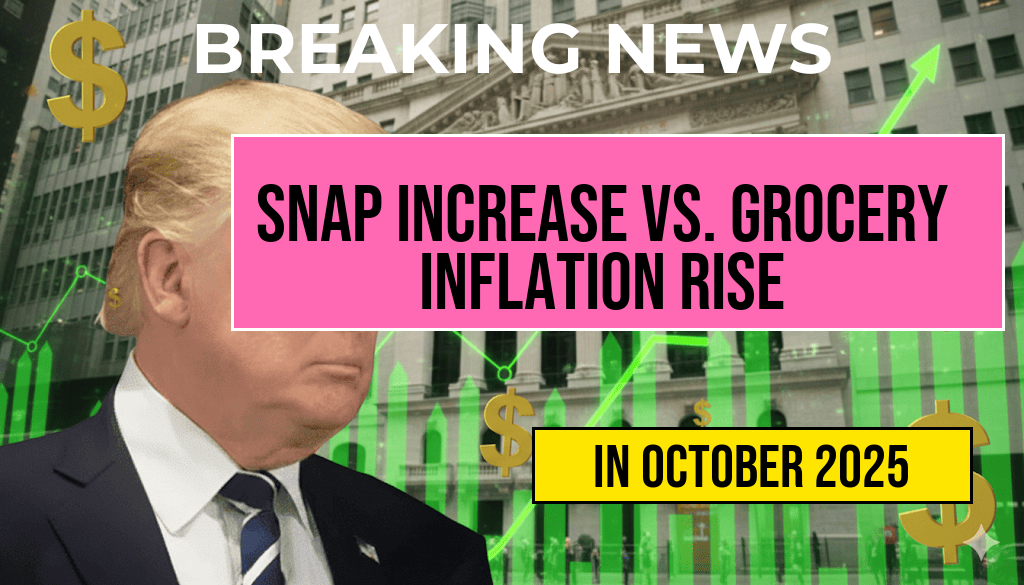The U.S. Department of Agriculture announced a modest increase in the Supplemental Nutrition Assistance Program (SNAP) benefits, raising the monthly allotment from $975 to $994. This $19 increase, effective immediately, comes at a time when grocery inflation continues to affect American households. Despite the adjustment aimed at helping low-income families cope with rising food prices, many recipients find that the increase falls short of addressing the ongoing financial strain caused by inflation. As prices for essential groceries remain elevated, the impact of this change raises questions about the adequacy of support provided to those most in need.
Understanding the SNAP Increase
The SNAP program, which provides crucial assistance to millions of low-income Americans, is designed to help individuals and families afford nutritious food. The increase in benefits is calculated based on various factors, including the cost of living and food prices. While the latest adjustment reflects an effort to keep pace with rising costs, the increase of just $19 per month has drawn scrutiny from advocates and recipients alike.
Current Grocery Inflation Trends
Grocery inflation has been a significant concern in recent months, with prices for basic food items climbing steadily. According to the U.S. Bureau of Labor Statistics, food prices have increased by approximately 10% over the past year, significantly impacting household budgets. This inflationary pressure means that consumers are paying more for staples such as:
- Meat and poultry
- Dairy products
- Fruits and vegetables
- Grains and cereals
Many families reliant on SNAP benefits are finding it increasingly challenging to make ends meet as the cost of living outpaces their financial support from the program. The $19 increase in benefits, while a positive step, does not align with the broader economic reality faced by these households.
Impact on SNAP Recipients
For many SNAP recipients, the increase may seem minimal compared to the rising costs of groceries. A recent survey revealed that approximately 60% of respondents felt that their current benefits were insufficient to cover their grocery expenses. With the average monthly cost of groceries for a family of four now estimated at over $1,000, the adjustment is far from adequate for most households.
Comparative Analysis of SNAP Benefits
| Benefit Amount (Previous) | Benefit Amount (Current) | Increase |
|---|---|---|
| $975 | $994 | $19 |
The table above illustrates the recent changes in SNAP benefits, which, while positive, may not significantly alleviate the burden of increased grocery costs. Many advocates argue that a more substantial adjustment is necessary to ensure that families can adequately feed themselves and their children.
Advocacy and Future Considerations
Food security advocates are calling for a reevaluation of the SNAP program to better align benefits with current economic conditions. Organizations like the Feeding America emphasize the need for a comprehensive approach to combat food insecurity that includes not only increased benefits but also initiatives to lower grocery prices.
As inflation continues to pose challenges for American families, policymakers are being urged to consider long-term solutions that address the root causes of food insecurity. Proposed measures include expanding access to food assistance programs, improving wages, and providing resources for nutritional education.
Conclusion
The recent $19 increase in SNAP benefits signals an awareness of the challenges faced by low-income households, yet it may not be enough to offset the realities of rising grocery inflation. With food prices continuing to climb, the need for a reevaluation of the program and more robust solutions remains critical. As discussions about food security evolve, the focus must shift toward ensuring that every American has access to affordable, nutritious food.
For further information on current food prices and assistance programs, visit the USDA ERS website or consult recent analyses by financial experts.
Frequently Asked Questions
What is the recent change in SNAP benefits?
The recent change in SNAP benefits resulted in an increase of $19 per month, raising the total from $975 to $994.
How is grocery inflation affecting SNAP recipients?
Grocery inflation has been rising, which means that the cost of food continues to increase, potentially impacting the purchasing power of SNAP recipients.
Will the $19 increase in SNAP benefits cover rising grocery costs?
The $19 increase may not fully offset the effects of grocery inflation, as prices for essential food items continue to rise significantly.
How often do SNAP benefits get adjusted?
Who qualifies for SNAP benefits?
Generally, individuals and families with low income or resources may qualify for SNAP benefits, but specific eligibility criteria vary by state.







